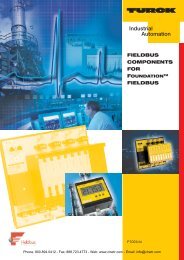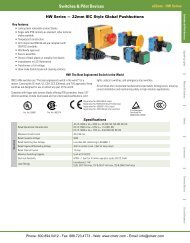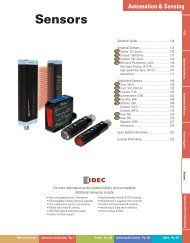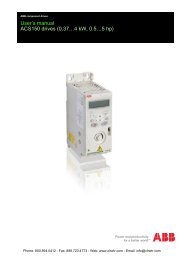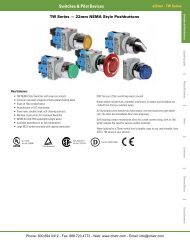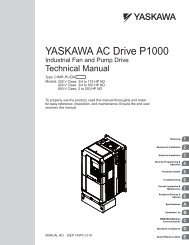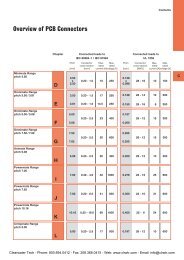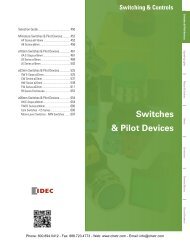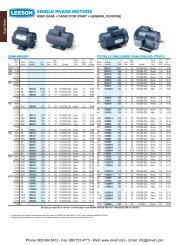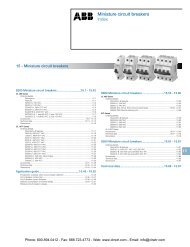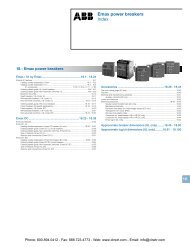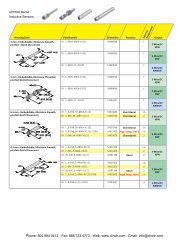Red Lion Model CUB7T Programmable General Purpose Electronic ...
Red Lion Model CUB7T Programmable General Purpose Electronic ...
Red Lion Model CUB7T Programmable General Purpose Electronic ...
Create successful ePaper yourself
Turn your PDF publications into a flip-book with our unique Google optimized e-Paper software.
Bulletin No. <strong>CUB7T</strong>1-K<br />
Drawing No. LP0414<br />
Released 6/08<br />
MODEL <strong>CUB7T</strong>1 PROGRAMMABLE GENERAL PURPOSE ELECTRONIC TIMER<br />
<br />
<br />
9 PROGRAMMABLE TIMER RANGES<br />
3 (8 Digit 0.35") LCD DISPLAY OPTIONS (Reflective, <strong>Red</strong><br />
Transmissive, Yellow/Green Transmissive) with “Timer Active”<br />
annunciator<br />
REPLACEABLE INTERNAL LITHIUM BATTERY (provides up to 6<br />
years of uninterrupted operation)<br />
BOTH FRONT PANEL PROGRAM AND RESET BUTTONS ARE<br />
INDIVIDUALLY ENABLED<br />
WIRE CONNECTIONS VIA SCREW CLAMP TYPE TERMINALS<br />
FRONT PANEL AND REMOTE RESET INPUT<br />
NEMA 4X/IP65 SEALED FRONT BEZEL<br />
DESCRIPTION<br />
The <strong>CUB7T</strong>1 is an 8-digit miniature programmable timer with large 0.35<br />
inch (8.90 mm) high digits. It has an LCD read-out available in Positive Image<br />
Reflective (<strong>CUB7T</strong>100), Negative Image Transmissive with yellow/green<br />
backlighting (<strong>CUB7T</strong>110) or red backlighting (<strong>CUB7T</strong>120). The backlight<br />
versions require an external 9 to 28 VDC power supply. The display will wrap<br />
around from a full display of “99999999” to “00000000” when an overflow<br />
occurs. An annunciator, located in the upper left hand corner of the display,<br />
blinks at 2 Hz when the signal input is activated. The <strong>CUB7T</strong>1 operates from<br />
a signal voltage of 10 to 300 V (AC 50/60 Hz or DC).<br />
The <strong>CUB7T</strong> timers use a CMOS LSI chip, mounted on a gold-plated<br />
substrate, that is electrically connected by ultrasonic wire-bonding. Proven<br />
micro-electronic assembly and manufacturing techniques provide these units<br />
with the reliability and dependability required for industrial service.<br />
The <strong>CUB7T</strong> series is housed in a lightweight, high impact plastic case with<br />
a clear viewing window. The sealed front panel with the silicone rubber<br />
buttons meets NEMA 4X/IP65 specifications for wash-down and/or dusty<br />
environments, when properly installed.<br />
SAFETY SUMMARY<br />
All safety related regulations, local codes and instructions that appear in the<br />
bulletin or on equipment must be observed to ensure personal safety and to<br />
prevent damage to either the instrument or equipment connected to it. If<br />
equipment is used in a manner not specified by the manufacturer, the protection<br />
provided by the equipment may be impaired.<br />
CAUTION: Risk of Danger.<br />
Read complete instructions prior to<br />
installation and operation of the unit.<br />
CAUTION: Risk of electric shock.<br />
SPECIFICATIONS<br />
1. DISPLAY: 8-digit LCD, 0.35" (8.90 mm) high digits.<br />
2. POWER SOURCE: Replaceable Internal 3.0 V lithium battery to provide up<br />
to 6 years of continuous operation. (Battery life is dependent upon usage.<br />
Contacts that remain closed for long periods of time reduce battery life.)<br />
3. BACKLIGHT POWER REQUIREMENTS: 9 to 28 VDC; 35 mA. typical,<br />
50 mA max. Above 26 VDC, derate max. operating temperature to 40°C.<br />
4. ANNUNCIATOR: Annunciator in the upper left corner of the display flashes<br />
at a 2 Hz rate when the signal input is activated.<br />
5. SIGNAL INPUT: (LS terminal #4)<br />
Voltage Input (<strong>CUB7T</strong>1xx): 10 V min. to 300 V max. (AC 50/60 Hz. or DC)<br />
to Common. 150 V max. for backlight versions. Input current 0.5 mA max.<br />
ANY off-state leakage current may activate the timer. Constant voltage<br />
applied to the input will actuate the timer. Due to the internal digital<br />
filtering to this input, up to 30 msec of error may be added per activation<br />
of the signal input.<br />
6. REMOTE RESET: 15 msec min. pulse width (active low) from 3.0 V<br />
bipolar output, an open collector transistor, or a switch contact to common.<br />
7. ACCURACY: 0.025% (+ up to 30 msec per activation of signal input—<br />
<strong>CUB7T</strong>1xx only)<br />
8. ENVIRONMENTAL CONDITIONS:<br />
Operating Temperature Range: 0 to 50°C Derate max. operating<br />
temperature to 40°C above 26 VDC (Backlight versions).<br />
Storage Temperature: -30 to 80°C<br />
Operating and Storage Humidity: 85% max. relative humidity (noncondensing)<br />
from 0°C to 50°C.<br />
Vibration According to IEC 68-2-6: Operational 5 to 500 Hz, in X, Y, Z<br />
direction for 1.5 hours, 5 g’s.<br />
Shock According to IEC 68-2-27: Operational 30 g, 11 msec in 3 directions.<br />
Altitude: Up to 2000 meters<br />
9. CERTIFICATIONS AND COMPLIANCES:<br />
SAFETY<br />
IEC 61010-1, EN 61010-1: Safety requirements for electrical equipment<br />
for measurement, control, and laboratory use, Part 1.<br />
IP65 Enclosure rating (Face only), IEC 529<br />
Type 4X Enclosure rating (Face only).<br />
DIMENSIONS In inches (mm)<br />
Note: Recommended minimum clearance (behind the panel) for mounting clip installation is<br />
2.1" (53.4) H x 5.5" (140) W.<br />
PANEL CUT-OUT<br />
Clearwater Tech - Phone: 800.894.0412 - Fax: 208.368.0415 - Web: www.clrwtr.com - Email: info@clrwtr.com
ELECTROMAGNETIC COMPATIBILITY<br />
Immunity to EN 50082-2<br />
Electrostatic discharge EN 61000-4-2 Level 2; 4 Kv contact<br />
RF interference EN 55022 Enclosure class B<br />
Notes<br />
1. Backlit powered units require a power line filter to be installed, RLC<br />
LFIL0000 or equivalent, so as not to impair the function of the<br />
backlighting.<br />
Refer to EMC Installation Guidelines for additional information.<br />
9. CONNECTIONS: Wire clamping screw terminals.<br />
Wire Strip Length: 0.3" (7.5 mm)<br />
Wire Gage: 30-14 AWG copper wire<br />
Torque: 5 inch-lbs (0.565 N-m) max<br />
10. CONSTRUCTION: High impact plastic case with clear viewing window.<br />
The front panel meets NEMA 4X/IP65 requirements for indoor use when<br />
properly installed. Installation Category I, Pollution Degree 2. Panel gasket<br />
and mounting clip included.<br />
11. WEIGHT: 2 oz. (57 grams) [with battery]<br />
TIMER RANGE SELECTION<br />
The <strong>CUB7T</strong>’s timer range can be modified in the Program mode. The<br />
Program mode uses the PGM button (refer to photo) to switch between Program<br />
and Operate modes. The RESET button (refer to photo) is used to select the<br />
desired timer range.<br />
Note: Timer range and accumulated time on the display will be lost if the<br />
battery is removed from the unit<br />
Connect wires between RST EN (Reset Enable) and COM. (Common); and<br />
between HS (Program Enable) and COM. (Common) to enable front push<br />
buttons. Press the PGM button to enter Program Mode, allowing selection of<br />
the desired timer range. The display will show 00000.000 (Timer Range 0.001<br />
sec). Repeatedly pressing the RST button will cycle through the available timer<br />
ranges as shown in the table. When the desired timer range is displayed, press<br />
PGM to load the range and return to operating mode. (The <strong>CUB7T</strong> will remain<br />
in Program Mode until the PGM button is pressed.) Remove the wire from the<br />
HS (Program Enable) terminal to<br />
prevent accidental changes to the<br />
timer range. Any new time<br />
accumulated will be at the new rate<br />
selected.<br />
Note: To avoid incorrect display<br />
information, it is recommended<br />
that the <strong>CUB7T</strong> be reset after<br />
making programming changes.<br />
Level 3; 8 Kv air<br />
Electromagnetic RF fields EN 61000-4-3 Level 3; 10 V/m<br />
80 MHz - 1 GHz<br />
Fast transients (burst) EN 61000-4-4 Level 4; 2 Kv I/O<br />
Level 3; 2 Kv power 1<br />
RF conducted interference EN 61000-4-6 Level 3; 10 V/rms<br />
150 KHz - 80 MHz<br />
Simulation of cordless telephone ENV 50204 Level 3; 10 V/m<br />
Emissions to EN 50081-1<br />
DISPLAY DURING<br />
PROGRAMMING<br />
00000.000<br />
111111.11<br />
2222222.2<br />
33333333<br />
4444444.4<br />
55555555<br />
666666.66<br />
7777777.7<br />
88888888<br />
9999.99.99<br />
900 MHz ± 5 MHz<br />
200 Hz, 50% duty cycle<br />
Timer Range<br />
0.001 Sec<br />
0.01 Sec<br />
0.1 Sec<br />
1 Sec<br />
0.1 Min<br />
1 Min<br />
0.01 Hr<br />
0.1 Hr<br />
1 Hr<br />
Factory Use Only<br />
INSTALLATION<br />
The <strong>CUB7T</strong> meets NEMA 4X/IP65 requirements for indoor use when<br />
properly installed. The units are intended to be mounted into an enclosed<br />
panel. The viewing window and reset button are factory sealed for a<br />
washdown environment. A sponge rubber gasket and mounting clip are<br />
provided for installing the unit in the panel cut-out.<br />
Installation Environment<br />
The unit should be installed in a location that does not exceed the<br />
maximum operating temperature and provides good air circulation. Placing<br />
the unit near devices that generate excessive heat should be avoided.<br />
The bezel should be cleaned only with a soft cloth and neutral soap<br />
product. Do NOT use solvents.<br />
Continuous exposure to direct sunlight may accelerate the aging process of<br />
the bezel.<br />
Do not use tools of any kind (screwdrivers, pens, pencils, etc.) to operate<br />
the push buttons of the unit.<br />
The following procedure assures proper installation:<br />
1. Cut panel opening to specified dimensions. Remove burrs and clean<br />
around panel opening.<br />
2. Carefully remove and discard the center section of the gasket.<br />
3. Slide the panel gasket over the rear of the counter body to the back of the<br />
bezel. Install <strong>CUB7T</strong> unit through the panel cut-out.<br />
4. Insert the mounting screws onto both sides of mounting clip. Tip of screw<br />
should NOT project from hole in mounting clip.<br />
5. Slide the mounting clip over the rear of the unit until the clip is against the<br />
back of the panel. The mounting clip has latching features which engage<br />
into mating features on the <strong>CUB7T</strong> housing.<br />
6. Note: It is necessary to hold the unit in place when sliding mounting clip<br />
into position.<br />
7. Alternately tighten each screw to ensure uniform gasket pressure.<br />
Visually inspect the front panel gasket. The gasket should be compressed<br />
to about 75 to 80% of its original thickness. If not, gradually turn mounting<br />
screws to further compress gasket.<br />
8. If the gasket is not adequately compressed and the mounting screws can no<br />
longer be turned, loosen mounting screws, and check that the mounting<br />
clip is latched as close as possible to the panel.<br />
9. Repeat from step #5 for tightening mounting screws.<br />
Clearwater Tech - Phone: 800.894.0412 - Fax: 208.368.0415 - Web: www.clrwtr.com - Email: info@clrwtr.com<br />
2
BATTERY INSTALLATION<br />
1. Remove all power to the unit before removing battery cover.<br />
2. To remove the battery cover, push upward in the direction of the arrow on<br />
the rear cover (See drawing at right), until the cover unlatches. Pull the<br />
cover straight out from unit to fully remove.<br />
3. Remove old battery* and replace it with an RLC battery (BNL10000).<br />
Observe proper polarity when replacing the battery as shown in the drawing.<br />
4. Replace the cover. The battery cover is keyed so that it cannot be placed<br />
upside down. The arrow on the rear of the cover should point toward the top<br />
of the <strong>CUB7T</strong> when properly installed.<br />
* - Dispose of properly.<br />
WARNING: Lithium battery may explode if incinerated.<br />
EMC INSTALLATION GUIDELINES<br />
Although this unit is designed with a high degree of immunity to<br />
ElectroMagnetic Interference (EMI), proper installation and wiring methods<br />
must be followed to ensure compatibility in each application. The type of the<br />
electrical noise, source or coupling method into the unit may be different for<br />
various installations. In extremely high EMI environments, additional measures<br />
may be needed. The unit becomes more immune to EMI with fewer I/O<br />
connections. Cable length, routing and shield termination are very important<br />
and can mean the difference between a successful or a troublesome installation.<br />
Listed below are some EMC guidelines for successful installation in an<br />
industrial environment.<br />
1. Use shielded (screened) cables for all Signal and Control inputs. The shield<br />
(screen) pigtail connection should be made as short as possible. The<br />
connection point for the shield depends somewhat upon the application.<br />
Listed below are the recommended methods of connecting the shield, in order<br />
of their effectiveness.<br />
a. Connect the shield only at the panel where the unit is mounted to earth<br />
ground (protective earth).<br />
b. Connect the shield to earth ground at both ends of the cable, usually when<br />
the noise source frequency is above 1 MHz.<br />
c. Connect the shield to common of the unit and leave the other end of the<br />
shield unconnected and insulated from earth ground.<br />
2. Never run Signal or Control cables in the same conduit or raceway with AC<br />
power lines, conductors feeding motors, solenoids, SCR controls, and<br />
heaters, etc. The cables should be run in metal conduit that is properly<br />
grounded. This is especially useful in applications where cable runs are long<br />
and portable two-way radios are used in close proximity or if the installation<br />
is near a commercial radio transmitter.<br />
3. Signal or Control cables within an enclosure should be routed as far away as<br />
possible from contactors, control relays, transformers, and other noisy<br />
components.<br />
4. In extremely high EMI environments, the use of external EMI suppression<br />
devices, such as ferrite suppression cores, is effective. Install them on Signal<br />
and Control cables as close to the unit as possible. Loop the cable through the<br />
core several times or use multiple cores on each cable for additional<br />
protection. Install line filters on the power input cable to the unit to suppress<br />
power line interference. Install them near the power entry point of the<br />
enclosure. The following EMI suppression devices (or equivalent) are<br />
recommended:<br />
Ferrite Suppression Cores for signal and control cables:<br />
Fair-Rite # 0443167251 (RLC #FCOR0000)<br />
TDK # ZCAT3035-1330A<br />
Steward #28B2029-0A0<br />
Line Filters for input power cables:<br />
Schaffner # FN610-1/07 (RLC #LFIL0000)<br />
Schaffner # FN670-1.8/07<br />
Corcom #1VR3<br />
Note: Reference manufacturer’s instructions when installing a line filter.<br />
5. Long cable runs are more susceptible to EMI pickup than short cable runs.<br />
Therefore, keep cable runs as short as possible.<br />
WIRING CONNECTIONS<br />
The electrical connections are made via screw-clamp terminals located on the<br />
back of the unit. All conductors should meet voltage and current ratings for each<br />
terminal. Also, cabling should conform to appropriate standards of good<br />
installation, local codes and regulations. It is recommended that power supplied<br />
to the unit be protected by a fuse or circuit breaker. When wiring the unit, use<br />
the battery cover to identify the wire position with the proper function. Strip the<br />
wire, leaving approximately 1/4" bare wire exposed (stranded wires should be<br />
tinned with solder). Insert the wire under the screw-clamp and tighten down the<br />
screw until the wire is clamped in tightly. Each terminal can accept up to two<br />
#14 AWG wires.<br />
WARNING: Lithium battery may explode if incinerated.<br />
CAUTION: All leads will be at the same line potential as the input<br />
leads.<br />
Clearwater Tech - Phone: 800.894.0412 - Fax: 208.368.0415 - Web: www.clrwtr.com - Email: info@clrwtr.com<br />
3
L.S. INPUT; VOLTAGE VERSIONS<br />
The <strong>CUB7T</strong> accepts most machine control voltage signals. The input accepts<br />
AC (50/60 Hz) or DC control voltages from 10 to 300 V. The unit times when<br />
voltage is applied between the LS input and Common. Any off-state leakage<br />
current may activate the timer.<br />
WARNING: Any lead may be at hazardous live input potential.<br />
External wiring and devices connected to the unit must be rated<br />
the same as applied signal input voltage and be properly<br />
isolated from Class 2 or SELV circuitry.<br />
RESET AND PROGRAM OPTIONS<br />
Connecting a wire from the RST EN (Reset Enable) or the HS (Program<br />
Enable) Input terminals to Common will enable the front panel Reset or<br />
Program buttons respectively.<br />
Pulling the “RST.” input low causes the timer to reset. The “RST.” can be<br />
pulled low by either a mechanical switch or solid-state transistor switch. The<br />
Switch load is 15 µA (max. voltage drop 0.5 V) when ON. The OFF-state<br />
leakage current must be less than 2 µA.<br />
Note: The RC protection circuit on the “RST.” Input causes a delay of<br />
approximately 15 msec in Reset response.<br />
BACKLIGHT OPTION<br />
Optional backlight versions of the <strong>CUB7T</strong> require an external 9 to 26 VDC<br />
power supply. The external supply is connected between the V+ and common<br />
terminals as shown in the drawing.<br />
WARNING: When connecting the wiring for a backlit <strong>CUB7T</strong><br />
measuring an AC input voltage, the neutral of the single phase<br />
AC signal is connected to Terminal 1 (COM), and line (hot) is<br />
connected to Terminal 4 (LS). The DC supply for the<br />
backlighting is connected as shown in the drawing. Three phase<br />
AC applications require an isolation transformer.<br />
APPLICATION<br />
A laundromat owner wants to monitor the cost of operating his dryers.<br />
He needs to know how many hours each dryer has operated. A <strong>CUB7T</strong>100<br />
(Voltage Input; Positive Image Reflective) is mounted on the back panel of<br />
each dryer. The signal input is connected across the motor of the dryer. The<br />
<strong>CUB7T</strong> will accumulate time while the dryer is running. On a regular basis<br />
the owner records the cumulative<br />
operating hours for each<br />
dryer and calculates if<br />
he needs to make any<br />
necessary adjustments. The<br />
timer can be reset via key<br />
switch.<br />
TROUBLESHOOTING<br />
For further technical assistance, contact technical support at the<br />
appropriate company numbers listed.<br />
ORDERING INFORMATION<br />
MODEL NO.<br />
*<strong>CUB7T</strong><br />
BNL<br />
VOLTAGE<br />
INPUT<br />
DESCRIPTION<br />
Timer; Positive Image Reflective<br />
Timer, w/Yel-Grn Backlighting<br />
Timer; w/<strong>Red</strong> Backlighting<br />
Replacement 3 V Lithium Battery<br />
PART<br />
NUMBER<br />
<strong>CUB7T</strong>100<br />
<strong>CUB7T</strong>110<br />
<strong>CUB7T</strong>120<br />
BNL10000<br />
*Battery is included with unit.<br />
Clearwater Tech - Phone: 800.894.0412 - Fax: 208.368.0415 - Web: www.clrwtr.com - Email: info@clrwtr.com
Bulletin No. <strong>CUB7T</strong>0-D<br />
Drawing No. LP0648<br />
Released 6/09<br />
MODEL <strong>CUB7T</strong>0 PROGRAMMABLE GENERAL PURPOSE ELECTRONIC TIMER<br />
• 9 PROGRAMMABLE TIMER RANGES<br />
• 3 (8 Digit 0.35") LCD DISPLAY OPTIONS (Reflective, <strong>Red</strong><br />
Transmissive, Yellow/Green Transmissive) with “Timer Active”<br />
annunciator<br />
• CONTACT INPUT<br />
• REPLACEABLE INTERNAL LITHIUM BATTERY (provides up to 6<br />
years of uninterrupted operation)<br />
• BOTH FRONT PANEL PROGRAM AND RESET BUTTONS ARE<br />
INDIVIDUALLY ENABLED<br />
• WIRE CONNECTIONS VIA SCREW CLAMP TYPE TERMINALS<br />
• FRONT PANEL AND REMOTE RESET INPUT<br />
• NEMA 4X/IP65 SEALED FRONT BEZEL<br />
DESCRIPTION<br />
The <strong>CUB7T</strong>0 is an 8-digit miniature programmable timer with large 0.35<br />
inch (8.90 mm) high digits. It has an LCD read-out available in Positive Image<br />
Reflective (<strong>CUB7T</strong>000), Negative Image Transmissive with yellow/green<br />
backlighting (<strong>CUB7T</strong>010) or red backlighting (<strong>CUB7T</strong>020). The backlight<br />
versions require an external 9 to 28 VDC power supply. The display will wrap<br />
around from a full display of “99999999” to “00000000” when an overflow<br />
occurs. An annunciator, located in the upper left hand corner of the display,<br />
blinks at 2 Hz when the signal input is activated. The <strong>CUB7T</strong>0 operates from<br />
a switch contact or an open collector NPN transistor.<br />
The <strong>CUB7T</strong> timers use a CMOS LSI chip, mounted on a gold-plated<br />
substrate, that is electrically connected by ultrasonic wire-bonding. Proven<br />
micro-electronic assembly and manufacturing techniques provide these units<br />
with the reliability and dependability required for industrial service.<br />
The <strong>CUB7T</strong> series is housed in a lightweight, high impact plastic case with<br />
a clear viewing window. The sealed front panel with the silicone rubber buttons<br />
meets NEMA 4X/IP65 specifications for wash-down and/or dusty environments,<br />
when properly installed.<br />
SAFETY SUMMARY<br />
All safety related regulations, local codes and instructions that appear in the<br />
manual or on equipment must be observed to ensure personal safety and to<br />
prevent damage to either the instrument or equipment connected to it. If<br />
equipment is used in a manner not specified by the manufacturer, the protection<br />
provided by the equipment may be impaired.<br />
Do not use this unit to directly command motors, valves, or other actuators<br />
not equipped with safeguards. To do so, can be potentially harmful to persons<br />
or equipment in the event of a fault to the unit.<br />
CAUTION: Risk of Danger.<br />
Read complete instructions prior to<br />
installation and operation of the unit.<br />
SPECIFICATIONS<br />
1. DISPLAY: 8-digit LCD, 0.35" (8.90 mm) high digits.<br />
2. POWER SOURCE: Replaceable Internal 3.0 V lithium battery to provide up<br />
to 6 years of continuous operation. (Battery life is dependent upon usage.<br />
Contacts that remain closed for long periods of time reduce battery life.)<br />
3. BACKLIGHT POWER REQUIREMENTS: 9 to 28 VDC; 35 mA. typical,<br />
50 mA max. Above 26 VDC, derate max. operating temperature to 40°C.<br />
Must use a NEC Class 2 or SELV rated power supply.<br />
4. ANNUNCIATOR: Annunciator in the upper left corner of the display flashes<br />
at a 2 Hz rate when the signal input is activated.<br />
5. SIGNAL INPUT: (LS terminal #4)<br />
Contact Input (<strong>CUB7T</strong>0xx): Switch Contact or solid state Transistor Switch<br />
to Common. Contact burden 15 μA max. A maintained closed switch to<br />
COM will actuate the timer.<br />
6. REMOTE RESET: 15 msec min. pulse width (active low) from 3.0 V<br />
bipolar output, an open collector transistor, or a switch contact to common.<br />
7. ACCURACY: 0.025%<br />
8. ENVIRONMENTAL CONDITIONS:<br />
Operating Temperature Range: 0 to 50 °C Derate max. operating<br />
temperature to 40 °C above 26 VDC (Backlight versions).<br />
Storage Temperature: -30 to 80 °C<br />
Operating and Storage Humidity: 85% max. relative humidity (noncondensing)<br />
from 0 °C to 50 °C.<br />
Vibration According to IEC 68-2-6: Operational 5 to 500 Hz, in X, Y, Z<br />
direction for 1.5 hours, 5 g’s.<br />
Shock According to IEC 68-2-27: Operational 30 g's, 11 msec in 3 directions.<br />
Altitude: Up to 2000 meters<br />
9. CONNECTIONS: Wire clamping screw terminals.<br />
Wire Strip Length: 0.3" (7.5 mm)<br />
Wire Gage: 30-14 AWG copper wire<br />
Torque: 5 inch-lbs (0.565 N-m) max<br />
10. CERTIFICATIONS AND COMPLIANCES:<br />
SAFETY<br />
Type 4X Indoor Enclosure rating (Face only)<br />
DIMENSIONS In inches (mm)<br />
85374216<br />
1.10 (27.9)<br />
Note: Recommended minimum clearance (behind the panel) for mounting clip installation is<br />
2.15" (53.4) H x 3.00" (140) W.<br />
0.11 (2.8)<br />
1.77<br />
+0.024<br />
-0.000<br />
PANEL CUT-OUT<br />
+0.6<br />
(45 -0.0 )<br />
0.87 (22.0) 0.874<br />
+0.012<br />
-0.000<br />
+0.3<br />
(22.2 )<br />
-0.0<br />
2.00 (50.8)<br />
0.10 (2.5) 1.56 (39.6)<br />
Clearwater Tech - Phone: 800.894.0412 - Fax: 208.368.0415 - Web: www.clrwtr.com - Email: info@clrwtr.com<br />
1
IEC-61010-1, EN 61010-1: Safety requirements for electrical equipment<br />
for measurement, control, and laboratory use, Part 1.<br />
IP65 Enclosure rating (Face only), IEC 529<br />
ELECTROMAGNETIC COMPATIBILITY<br />
Immunity to EN 50082-2<br />
Electrostatic discharge EN 61000-4-2 Level 2; 4 Kv contact<br />
Level 3; 8 Kv air<br />
Electromagnetic RF fields EN 61000-4-3 Level 3; 10 V/m<br />
80 MHz - 1 GHz<br />
Fast transients (burst) EN 61000-4-4 Level 4; 2 Kv I/O<br />
Level 3; 2 Kv power 1<br />
RF conducted interference EN 61000-4-6 Level 3; 10 V/rms<br />
150 KHz - 80 MHz<br />
Simulation of cordless telephone ENV 50204 Level 3; 10 V/m<br />
900 MHz ± 5 MHz<br />
200 Hz, 50% duty cycle<br />
Emissions to EN 50081-1<br />
RF interference EN 55022 Enclosure class B<br />
Notes<br />
1. Backlit powered units require a power line filter to be installed,<br />
RLC LFIL0000 or equivalent, so as not to impair the function of the<br />
backlighting.<br />
Refer to EMC Installation Guidelines for additional information.<br />
11. CONSTRUCTION: High impact plastic case with clear viewing window.<br />
The front panel meets NEMA 4X/IP65 requirements for indoor use when<br />
properly installed. Installation Category I, Pollution Degree 2. Panel gasket<br />
and mounting clip included.<br />
12. WEIGHT: 2 oz. (57 grams) [with battery]<br />
TIMER RANGE SELECTION<br />
The <strong>CUB7T</strong>’s timer range can be modified in the Program mode. The<br />
Program mode uses the PGM button (refer to photo) to switch between<br />
Program and Operate modes. The RESET button (refer to photo) is used to<br />
select the desired timer range.<br />
Note: Timer range and accumulated time on the display will be lost if the<br />
battery is removed from the unit<br />
ANNUNCIATOR<br />
PGM<br />
Connect wires between RST EN (Reset Enable) and COM. (Common); and<br />
between HS (Program Enable) and COM. (Common) to enable front push<br />
buttons. Press the PGM button to enter Program Mode, allowing selection of<br />
the desired timer range. The display will show 00000.000 (Timer Range 0.001<br />
sec). Repeatedly pressing the RST button will cycle through the available timer<br />
ranges as shown in the table.<br />
When the desired timer range is<br />
displayed, press PGM to load the<br />
range and return to operating<br />
mode. (The <strong>CUB7T</strong> will remain<br />
in Program Mode until the PGM<br />
button is pressed.) Remove the<br />
wire from the HS (Program<br />
Enable) terminal to prevent<br />
accidental changes to the timer<br />
range. Any new time accumulated<br />
will be at the new rate selected.<br />
Note: To avoid incorrect display<br />
information, it is recommended<br />
that the <strong>CUB7T</strong> be reset after<br />
making programming changes.<br />
RST<br />
DISPLAY DURING<br />
PROGRAMMING<br />
Timer Range<br />
00000.000 0.001 Sec<br />
111111.11 0.01 Sec<br />
2222222.2 0.1 Sec<br />
33333333 1 Sec<br />
4444444.4 0.1 Min<br />
55555555 1 Min<br />
666666.66 0.01 Hr<br />
7777777.7 0.1 Hr<br />
88888888 1 Hr<br />
9999.99.99 Factory Use Only<br />
INSTALLATION<br />
The <strong>CUB7T</strong> meets NEMA 4X/IP65 requirements for indoor use when<br />
properly installed. The units are intended to be mounted into an enclosed<br />
panel. The viewing window and reset button are factory sealed for a<br />
washdown environment. A sponge rubber gasket and mounting clip are<br />
provided for installing the unit in the panel cut-out.<br />
Installation Environment<br />
The unit should be installed in a location that does not exceed the<br />
maximum operating temperature and provides good air circulation. Placing<br />
the unit near devices that generate excessive heat should be avoided.<br />
The bezel should be cleaned only with a soft cloth and neutral soap<br />
product. Do NOT use solvents.<br />
Continuous exposure to direct sunlight may accelerate the aging process of<br />
the bezel.<br />
Do not use tools of any kind (screwdrivers, pens, pencils, etc.) to operate<br />
the push buttons of the unit.<br />
EXISTING<br />
PANEL<br />
0.05" to 0.20"<br />
(1.3 to 5.1 mm)<br />
THICK<br />
MOUNTING<br />
SCREW<br />
3-RST EN<br />
1-COM<br />
5-RST<br />
LS-4<br />
+V-2<br />
HS-6<br />
MOUNTING<br />
CLIP<br />
LATCHING<br />
FEATURE<br />
GASKET<br />
0.062"<br />
(1.57 mm)<br />
THICK<br />
BEZEL<br />
The following procedure assures proper installation:<br />
1. Cut panel opening to specified dimensions. Remove burrs and clean<br />
around panel opening.<br />
2. Carefully remove and discard the center section of the gasket.<br />
3. Slide the panel gasket over the rear of the counter body to the back of the<br />
bezel. Install <strong>CUB7T</strong> unit through the panel cut-out.<br />
4. Insert the mounting screws onto both sides of mounting clip. Tip of screw<br />
should NOT project from hole in mounting clip.<br />
5. Slide the mounting clip over the rear of the unit until the clip is against the<br />
back of the panel. The mounting clip has latching features which engage<br />
into mating features on the <strong>CUB7T</strong> housing.<br />
6. Note: It is necessary to hold the unit in place when sliding mounting clip<br />
into position.<br />
7. Alternately tighten each screw to ensure uniform gasket pressure.<br />
Visually inspect the front panel gasket. The gasket should be compressed<br />
to about 75 to 80% of its original thickness. If not, gradually turn mounting<br />
screws to further compress gasket.<br />
8. If the gasket is not adequately compressed and the mounting screws can no<br />
longer be turned, loosen mounting screws, and check that the mounting<br />
clip is latched as close as possible to the panel.<br />
9. Repeat from step #5 for tightening mounting screws.<br />
TROUBLESHOOTING<br />
For further technical assistance, contact technical support at the appropriate<br />
company numbers listed.<br />
Clearwater Tech - Phone: 800.894.0412 - Fax: 208.368.0415 - Web: www.clrwtr.com - Email: info@clrwtr.com
BATTERY INSTALLATION<br />
1. Remove all power to the unit before removing battery cover.<br />
2. To remove the battery cover, push upward in the direction of the arrow on<br />
the rear cover (See drawing at right), until the cover unlatches. Pull the<br />
cover straight out from unit to fully remove.<br />
3. Remove old battery* and replace it with an RLC battery (BNL10000).<br />
Observe proper polarity when replacing the battery as shown in the drawing.<br />
4. Replace the cover. The battery cover is keyed so that it cannot be placed<br />
upside down. The arrow on the rear of the cover should point toward the top<br />
of the <strong>CUB7T</strong> when properly installed.<br />
* - Dispose of properly.<br />
- +<br />
3-RST EN<br />
1-COM<br />
5-RST<br />
TOP OF<br />
UNIT<br />
3-RST EN<br />
1-COM<br />
5-RST<br />
LS-4<br />
V+-2<br />
HS-6<br />
4-LS<br />
2-V+<br />
6-HS<br />
BATTERY COVER-<br />
Push up to<br />
unlatch cover.<br />
WARNING: Lithium battery may explode if incinerated.<br />
EMC INSTALLATION GUIDELINES<br />
Although this unit is designed with a high degree of immunity to<br />
ElectroMagnetic Interference (EMI), proper installation and wiring methods<br />
must be followed to ensure compatibility in each application. The type of the<br />
electrical noise, source or coupling method into the unit may be different for<br />
various installations. In extremely high EMI environments, additional measures<br />
may be needed. The unit becomes more immune to EMI with fewer I/O<br />
connections. Cable length, routing and shield termination are very important<br />
and can mean the difference between a successful or a troublesome installation.<br />
Listed below are some EMC guidelines for successful installation in an<br />
industrial environment.<br />
1. Use shielded (screened) cables for all Signal and Control inputs. The shield<br />
(screen) pigtail connection should be made as short as possible. The<br />
connection point for the shield depends somewhat upon the application.<br />
Listed below are the recommended methods of connecting the shield, in order<br />
of their effectiveness.<br />
a. Connect the shield only at the panel where the unit is mounted to earth<br />
ground (protective earth).<br />
b. Connect the shield to earth ground at both ends of the cable, usually when<br />
the noise source frequency is above 1 MHz.<br />
c. Connect the shield to common of the unit and leave the other end of the<br />
shield unconnected and insulated from earth ground.<br />
2. Never run Signal or Control cables in the same conduit or raceway with AC<br />
power lines, conductors feeding motors, solenoids, SCR controls, and<br />
heaters, etc. The cables should be run in metal conduit that is properly<br />
grounded. This is especially useful in applications where cable runs are long<br />
and portable two-way radios are used in close proximity or if the installation<br />
is near a commercial radio transmitter.<br />
3. Signal or Control cables within an enclosure should be routed as far away as<br />
possible from contactors, control relays, transformers, and other noisy<br />
components.<br />
4. In extremely high EMI environments, the use of external EMI suppression<br />
devices, such as ferrite suppression cores, is effective. Install them on Signal<br />
and Control cables as close to the unit as possible. Loop the cable through the<br />
core several times or use multiple cores on each cable for additional<br />
protection. Install line filters on the power input cable to the unit to suppress<br />
power line interference. Install them near the power entry point of the<br />
enclosure. The following EMI suppression devices (or equivalent) are<br />
recommended:<br />
L.S. INPUT; CONTACT VERSIONS<br />
+3V<br />
Ferrite Suppression Cores for signal and control cables:<br />
Fair-Rite # 0443167251 (RLC #FCOR0000)<br />
TDK # ZCAT3035-1330A<br />
Steward #28B2029-0A0<br />
Line Filters for input power cables:<br />
Schaffner # FN610-1/07 (RLC #LFIL0000)<br />
Schaffner # FN670-1.8/07<br />
Corcom #1VR3<br />
Note: Reference manufacturer’s instructions when installing a line filter.<br />
5. Long cable runs are more susceptible to EMI pickup than short cable runs.<br />
Therefore, keep cable runs as short as possible.<br />
WIRING CONNECTIONS<br />
The electrical connections are made via screw-clamp terminals located on the<br />
back of the unit. All conductors should meet voltage and current ratings for each<br />
terminal. Also, cabling should conform to appropriate standards of good<br />
installation, local codes and regulations. It is recommended that power supplied<br />
to the unit be protected by a fuse or circuit breaker. When wiring the unit, use<br />
the battery cover to identify the wire position with the proper function. Strip the<br />
wire, leaving approximately 1/4" bare wire exposed (stranded wires should be<br />
tinned with solder). Insert the wire under the screw-clamp and tighten down the<br />
screw until the wire is clamped in tightly. Each terminal can accept up to two<br />
#14 AWG wires.<br />
SWITCH<br />
CONTACT<br />
INPUT<br />
3-RST EN<br />
1-COM<br />
5-RST<br />
LS-4<br />
V+-2<br />
HS-6<br />
WARNING: Lithium battery may explode if incinerated.<br />
NPN<br />
O.C. TRANSISTOR<br />
OR (N) FET<br />
INPUT<br />
SIGNAL<br />
INPUT<br />
PROGRAM<br />
ENABLE<br />
PNP<br />
O.C. TRANSISTOR<br />
OR (P) FET<br />
INPUT<br />
220K<br />
LS<br />
LS<br />
LS<br />
T<br />
220K<br />
LS<br />
MICRO<br />
CHIP<br />
.01µf<br />
BATT.<br />
3.0V<br />
COM<br />
COM/NEUTRAL<br />
Connecting the “L.S.” Input to Common with a mechanical or solid-state<br />
switch activates the timer. Releasing the connection, deactivates the timer. The<br />
switch load is 15 A (max. voltage drop 0.5 V) when ON. The OFF-state<br />
leakage current must be less than 2 A.<br />
COM<br />
COM<br />
COM<br />
Reed switches, mercury wetted contacts, snap action limit switches, and<br />
silver alloy relay contacts with wiping action are usually satisfactory for input<br />
activation. Motor starter contacts, tungsten contacts, and brush-type contacts<br />
should not be used.<br />
Clearwater Tech - Phone: 800.894.0412 - Fax: 208.368.0415 - Web: www.clrwtr.com - Email: info@clrwtr.com
RESET AND PROGRAM OPTIONS<br />
Connecting a wire from the RST EN (Reset Enable) or the HS (Program<br />
Enable) Input terminals to Common will enable the front panel Reset or<br />
Program buttons respectively.<br />
Pulling the “RST.” input low causes the timer to reset. The “RST.” can be<br />
pulled low by either a mechanical switch or solid-state transistor switch. The<br />
Switch load is 15 μA (max. voltage drop 0.5 V) when ON. The OFF-state<br />
leakage current must be less than 2 μA.<br />
Note: The RC protection circuit on the “RST.” Input causes a delay of<br />
approximately 15 msec in Reset response.<br />
BACKLIGHT OPTION<br />
Optional backlight versions of the <strong>CUB7T</strong> require an external 9 to 26<br />
VDC power supply. The external supply is connected between the V+ and<br />
common terminals as shown in the drawing.<br />
3-RST EN<br />
1-COM<br />
5-RST<br />
LS-4<br />
V+-2<br />
HS-6<br />
RST. EN.<br />
FRONT<br />
PANEL<br />
RESET<br />
+3V<br />
R<br />
0.022µF<br />
220K<br />
RST.<br />
-<br />
9-26 VDC<br />
POWER SUPPLY<br />
(Backlighting)<br />
+<br />
220K<br />
PROGRAM<br />
MICRO<br />
CHIP<br />
P<br />
BATT.<br />
3.0V<br />
REMOTE<br />
RESET<br />
COM<br />
COM/NEUTRAL<br />
HS<br />
APPLICATION<br />
A bottling company has a preventive maintenance program<br />
based on the accumulative running hours. For each bottling<br />
line, they added a <strong>CUB7T</strong>000. When the line is running a<br />
contact closure is given to the <strong>CUB7T</strong> timer allowing the new<br />
time to accumulate with the hours of previous operations. At a<br />
designated value, the line maintenance is performed and the<br />
<strong>CUB7T</strong> is reset with a key switch to 0.<br />
CONTACT<br />
CLOSURE<br />
3-RST EN<br />
1-COM<br />
5-RST<br />
LS-4<br />
V+-2<br />
HS-6<br />
ORDERING INFORMATION<br />
MODEL NO. DESCRIPTION PART NUMBER<br />
Timer; Positive Image Reflective <strong>CUB7T</strong>000<br />
CONTACT<br />
*<strong>CUB7T</strong><br />
INPUT<br />
Timer, w/Yel-Grn Backlighting <strong>CUB7T</strong>010<br />
Timer; w/<strong>Red</strong> Backlighting<br />
<strong>CUB7T</strong>020<br />
BNL Replacement 3 V Lithium Battery BNL10000<br />
*Battery is included with unit.<br />
LIMITED WARRANTY<br />
The Company warrants the products it manufactures against defects in materials and<br />
workmanship for a period limited to two years from the date of shipment, provided the<br />
products have been stored, handled, installed, and used under proper conditions. The<br />
Company’s liability under this limited warranty shall extend only to the repair or<br />
replacement of a defective product, at The Company’s option. The Company disclaims<br />
all liability for any affirmation, promise or representation with respect to the products.<br />
The customer agrees to hold <strong>Red</strong> <strong>Lion</strong> Controls harmless from, defend, and indemnify<br />
RLC against damages, claims, and expenses arising out of subsequent sales of RLC<br />
products or products containing components manufactured by RLC and based upon<br />
personal injuries, deaths, property damage, lost profits, and other matters which Buyer,<br />
its employees, or sub-contractors are or may be to any extent liable, including without<br />
limitation penalties imposed by the Consumer Product Safety Act (P.L. 92-573) and<br />
liability imposed upon any person pursuant to the Magnuson-Moss Warranty Act (P.L.<br />
93-637), as now in effect or as amended hereafter.<br />
No warranties expressed or implied are created with respect to The Company’s products<br />
except those expressly contained herein. The Customer acknowledges the disclaimers<br />
and limitations contained herein and relies on no other warranties or affirmations.<br />
Clearwater Tech - Phone: 800.894.0412 - Fax: 208.368.0415 - Web: www.clrwtr.com - Email: info@clrwtr.com
Bulletin No. <strong>CUB7T</strong>3-A(1)<br />
Drawing No. LP0701<br />
Released 6/09<br />
MODEL <strong>CUB7T</strong>3 PROGRAMMABLE GENERAL PURPOSE ELECTRONIC TIMER<br />
• 9 PROGRAMMABLE TIMER RANGES<br />
• 3 (8 Digit 0.35") LCD DISPLAY OPTIONS (Reflective, <strong>Red</strong><br />
Transmissive, Yellow/Green Transmissive) with “Timer Active”<br />
annunciator<br />
• REPLACEABLE INTERNAL LITHIUM BATTERY (provides up to 6<br />
years of uninterrupted operation)<br />
• BOTH FRONT PANEL PROGRAM AND RESET BUTTONS ARE<br />
INDIVIDUALLY ENABLED<br />
• WIRE CONNECTIONS VIA SCREW CLAMP TYPE TERMINALS<br />
• FRONT PANEL AND REMOTE RESET INPUT<br />
• NEMA 4X/IP65 SEALED FRONT BEZEL<br />
DESCRIPTION<br />
The <strong>CUB7T</strong>3 is an 8-digit miniature programmable timer with large 0.35<br />
inch (8.90 mm) high digits. It has an LCD read-out available in Positive Image<br />
Reflective (<strong>CUB7T</strong>300), Negative Image Transmissive with yellow/green<br />
backlighting (<strong>CUB7T</strong>310) or red backlighting (<strong>CUB7T</strong>320). The backlight<br />
versions require an external 9 to 28 VDC power supply. The display will wrap<br />
around from a full display of “99999999” to “00000000” when an overflow<br />
occurs. An annunciator, located in the upper left hand corner of the display,<br />
blinks at 2 Hz when the signal input is activated. The <strong>CUB7T</strong>3 operates from<br />
a signal voltage of 10 to 30 V (AC 50/60 Hz or DC).<br />
The <strong>CUB7T</strong> timers use a CMOS LSI chip, mounted on a gold-plated<br />
substrate, that is electrically connected by ultrasonic wire-bonding. Proven<br />
micro-electronic assembly and manufacturing techniques provide these units<br />
with the reliability and dependability required for industrial service.<br />
The <strong>CUB7T</strong> series is housed in a lightweight, high impact plastic case with<br />
a clear viewing window. The sealed front panel with the silicone rubber<br />
buttons meets NEMA 4X/IP65 specifications for wash-down and/or dusty<br />
environments, when properly installed.<br />
SAFETY SUMMARY<br />
All safety related regulations, local codes and instructions that appear in the<br />
bulletin or on equipment must be observed to ensure personal safety and to<br />
prevent damage to either the instrument or equipment connected to it. If<br />
equipment is used in a manner not specified by the manufacturer, the protection<br />
provided by the equipment may be impaired.<br />
DIMENSIONS In inches (mm)<br />
85374216<br />
CAUTION: Risk of Danger.<br />
Read complete instructions prior to<br />
installation and operation of the unit.<br />
1.10 (27.9)<br />
SPECIFICATIONS<br />
1. DISPLAY: 8-digit LCD, 0.35" (8.90 mm) high digits.<br />
2. POWER SOURCE: Replaceable Internal 3.0 V lithium battery to provide up<br />
to 6 years of continuous operation. (Battery life is dependent upon usage.<br />
Contacts that remain closed for long periods of time reduce battery life.)<br />
3. BACKLIGHT POWER REQUIREMENTS: 9 to 28 VDC; 35 mA. typical,<br />
50 mA max. Above 26 VDC, derate max. operating temperature to 40°C.<br />
Must use a NEC Class 2 or SELV rated power supply.<br />
4. ANNUNCIATOR: Annunciator in the upper left corner of the display flashes<br />
at a 2 Hz rate when the signal input is activated.<br />
5. SIGNAL INPUT: (LS terminal #4)<br />
Voltage Input: 10 V min. to 30 V max. (AC 50/60 Hz. or DC) to Common.<br />
ANY off-state leakage current may activate the timer. Constant voltage<br />
applied to the input will actuate the timer. Due to the internal digital<br />
filtering to this input, up to 30 msec of error may be added per activation<br />
of the signal input. Must use a NEC or a Class 2 or SELV rated power<br />
supply.<br />
6. REMOTE RESET: 15 msec min. pulse width (active low) from 3.0 V<br />
bipolar output, an open collector transistor, or a switch contact to common.<br />
7. ACCURACY: 0.025%<br />
8. ENVIRONMENTAL CONDITIONS:<br />
Operating Temperature Range: 0 to 50°C Derate max. operating<br />
temperature to 40°C above 26 VDC (Backlight versions).<br />
Storage Temperature: -30 to 80°C<br />
Operating and Storage Humidity: 85% max. relative humidity (noncondensing)<br />
from 0°C to 50°C.<br />
Vibration According to IEC 68-2-6: Operational 5 to 500 Hz, in X, Y, Z<br />
direction for 1.5 hours, 5 g’s.<br />
Shock According to IEC 68-2-27: Operational 30 g's, 11 msec in 3 directions.<br />
Altitude: Up to 2000 meters<br />
9. CERTIFICATIONS AND COMPLIANCES:<br />
SAFETY<br />
IEC 61010-1, EN 61010-1: Safety requirements for electrical equipment<br />
for measurement, control, and laboratory use, Part 1.<br />
IP65 Enclosure rating (Face only), IEC 529<br />
Type 4X Indoor Enclosure rating (Face only)<br />
Note: Recommended minimum clearance (behind the panel) for mounting clip<br />
installation is 2.1" (53.4) H x 5.5" (140) W.<br />
0.11 (2.8)<br />
1.77<br />
PANEL CUT-OUT<br />
+0.024<br />
-0.000<br />
+0.6<br />
(45 -0.0 )<br />
0.87 (22.0) 0.874<br />
+0.012<br />
-0.000<br />
+0.3<br />
(22.2 )<br />
-0.0<br />
2.00 (50.8)<br />
0.10 (2.5) 1.56 (39.6)<br />
Clearwater Tech - Phone: 800.894.0412 - Fax: 208.368.0415 - Web: www.clrwtr.com - Email: info@clrwtr.com
ELECTROMAGNETIC COMPATIBILITY<br />
Immunity to EN 50082-2<br />
Electrostatic discharge EN 61000-4-2 Level 2; 4 Kv contact<br />
Level 3; 8 Kv air<br />
Electromagnetic RF fields EN 61000-4-3 Level 3; 10 V/m<br />
80 MHz - 1 GHz<br />
Fast transients (burst) EN 61000-4-4 Level 4; 2 Kv I/O<br />
Level 3; 2 Kv power 1<br />
RF conducted interference EN 61000-4-6 Level 3; 10 V/rms<br />
150 KHz - 80 MHz<br />
Simulation of cordless telephone ENV 50204 Level 3; 10 V/m<br />
900 MHz ± 5 MHz<br />
200 Hz, 50% duty cycle<br />
Emissions to EN 50081-1<br />
RF interference EN 55022 Enclosure class B<br />
Notes<br />
1. Backlit powered units require a power line filter to be installed, RLC<br />
LFIL0000 or equivalent, so as not to impair the function of the<br />
backlighting.<br />
Refer to EMC Installation Guidelines for additional information.<br />
9. CONNECTIONS: Wire clamping screw terminals.<br />
Wire Strip Length: 0.3" (7.5 mm)<br />
Wire Gage: 30-14 AWG copper wire<br />
Torque: 5 inch-lbs (0.565 N-m) max<br />
10. CONSTRUCTION: High impact plastic case with clear viewing window.<br />
The front panel meets NEMA 4X/IP65 requirements for indoor use when<br />
properly installed. Installation Category I, Pollution Degree 2. Panel gasket<br />
and mounting clip included.<br />
11. WEIGHT: 2 oz. (57 grams) [with battery]<br />
TIMER RANGE SELECTION<br />
The <strong>CUB7T</strong>’s timer range can be modified in the Program mode. The<br />
Program mode uses the PGM button (refer to photo) to switch between Program<br />
and Operate modes. The RESET button (refer to photo) is used to select the<br />
desired timer range.<br />
Note: Timer range and accumulated time on the display will be lost if the battery<br />
is removed from the unit<br />
PGM<br />
Connect wires between RST EN (Reset Enable) and COM. (Common); and<br />
between HS (Program Enable) and COM. (Common) to enable front push<br />
buttons. Press the PGM button to enter Program Mode, allowing selection of the<br />
desired timer range. The display will show 00000.000 (Timer Range 0.001 sec).<br />
Repeatedly pressing the RST button will cycle through the available timer<br />
ranges as shown in the table. When the desired timer range is displayed, press<br />
PGM to load the range and return to operating mode. (The <strong>CUB7T</strong> will remain<br />
in Program Mode until the PGM button is pressed.) Remove the wire from the<br />
HS (Program Enable) terminal to<br />
prevent accidental changes to the<br />
timer range. Any new time<br />
accumulated will be at the new rate<br />
selected.<br />
Note: To avoid incorrect display<br />
information, it is recommended<br />
that the <strong>CUB7T</strong> be reset after<br />
making programming changes.<br />
ANNUNCIATOR<br />
DISPLAY DURING<br />
PROGRAMMING<br />
00000.000<br />
111111.11<br />
2222222.2<br />
33333333<br />
4444444.4<br />
55555555<br />
666666.66<br />
7777777.7<br />
88888888<br />
9999.99.99<br />
RST<br />
Timer Range<br />
0.001 Sec<br />
0.01 Sec<br />
0.1 Sec<br />
1 Sec<br />
0.1 Min<br />
1 Min<br />
0.01 Hr<br />
0.1 Hr<br />
1 Hr<br />
Factory Use Only<br />
INSTALLATION<br />
The <strong>CUB7T</strong> meets NEMA 4X/IP65 requirements for indoor use when<br />
properly installed. The units are intended to be mounted into an enclosed<br />
panel. The viewing window and reset button are factory sealed for a<br />
washdown environment. A sponge rubber gasket and mounting clip are<br />
provided for installing the unit in the panel cut-out.<br />
Installation Environment<br />
The unit should be installed in a location that does not exceed the<br />
maximum operating temperature and provides good air circulation. Placing<br />
the unit near devices that generate excessive heat should be avoided.<br />
The bezel should be cleaned only with a soft cloth and neutral soap<br />
product. Do NOT use solvents.<br />
Continuous exposure to direct sunlight may accelerate the aging process of<br />
the bezel.<br />
Do not use tools of any kind (screwdrivers, pens, pencils, etc.) to operate<br />
the push buttons of the unit.<br />
EXISTING<br />
PANEL<br />
0.05" to 0.20"<br />
(1.3 to 5.1 mm)<br />
THICK<br />
MOUNTING<br />
SCREW<br />
3-RST EN<br />
1-COM<br />
5-RST<br />
LS-4<br />
+V-2<br />
HS-6<br />
MOUNTING<br />
CLIP<br />
LATCHING<br />
FEATURE<br />
GASKET<br />
0.062"<br />
(1.57 mm)<br />
THICK<br />
BEZEL<br />
The following procedure assures proper installation:<br />
1. Cut panel opening to specified dimensions. Remove burrs and clean<br />
around panel opening.<br />
2. Carefully remove and discard the center section of the gasket.<br />
3. Slide the panel gasket over the rear of the counter body to the back of the<br />
bezel. Install <strong>CUB7T</strong> unit through the panel cut-out.<br />
4. Insert the mounting screws onto both sides of mounting clip. Tip of screw<br />
should NOT project from hole in mounting clip.<br />
5. Slide the mounting clip over the rear of the unit until the clip is against the<br />
back of the panel. The mounting clip has latching features which engage<br />
into mating features on the <strong>CUB7T</strong> housing.<br />
6. Note: It is necessary to hold the unit in place when sliding mounting clip<br />
into position.<br />
7. Alternately tighten each screw to ensure uniform gasket pressure.<br />
Visually inspect the front panel gasket. The gasket should be compressed<br />
to about 75 to 80% of its original thickness. If not, gradually turn mounting<br />
screws to further compress gasket.<br />
8. If the gasket is not adequately compressed and the mounting screws can no<br />
longer be turned, loosen mounting screws, and check that the mounting<br />
clip is latched as close as possible to the panel.<br />
9. Repeat from step #5 for tightening mounting screws.<br />
Clearwater Tech - Phone: 800.894.0412 - Fax: 208.368.0415 - Web: www.clrwtr.com - Email: info@clrwtr.com
BATTERY INSTALLATION<br />
1. Remove all power to the unit before removing battery cover.<br />
2. To remove the battery cover, push upward in the direction of the arrow on<br />
the rear cover (See drawing at right), until the cover unlatches. Pull the<br />
cover straight out from unit to fully remove.<br />
3. Remove old battery* and replace it with an RLC battery (BNL10000).<br />
Observe proper polarity when replacing the battery as shown in the drawing.<br />
4. Replace the cover. The battery cover is keyed so that it cannot be placed<br />
upside down. The arrow on the rear of the cover should point toward the top<br />
of the <strong>CUB7T</strong> when properly installed.<br />
* - Dispose of properly.<br />
- +<br />
3-RST EN<br />
1-COM<br />
5-RST<br />
TOP OF<br />
UNIT<br />
3-RST EN<br />
1-COM<br />
5-RST<br />
LS-4<br />
V+-2<br />
HS-6<br />
4-LS<br />
2-V+<br />
BATTERY COVER-<br />
Push up to<br />
unlatch cover.<br />
WARNING: Lithium battery may explode if incinerated.<br />
6-HS<br />
EMC INSTALLATION GUIDELINES<br />
Although this unit is designed with a high degree of immunity to<br />
ElectroMagnetic Interference (EMI), proper installation and wiring methods<br />
must be followed to ensure compatibility in each application. The type of the<br />
electrical noise, source or coupling method into the unit may be different for<br />
various installations. In extremely high EMI environments, additional measures<br />
may be needed. The unit becomes more immune to EMI with fewer I/O<br />
connections. Cable length, routing and shield termination are very important<br />
and can mean the difference between a successful or a troublesome installation.<br />
Listed below are some EMC guidelines for successful installation in an<br />
industrial environment.<br />
1. Use shielded (screened) cables for all Signal and Control inputs. The shield<br />
(screen) pigtail connection should be made as short as possible. The<br />
connection point for the shield depends somewhat upon the application.<br />
Listed below are the recommended methods of connecting the shield, in order<br />
of their effectiveness.<br />
a. Connect the shield only at the panel where the unit is mounted to earth<br />
ground (protective earth).<br />
b. Connect the shield to earth ground at both ends of the cable, usually when<br />
the noise source frequency is above 1 MHz.<br />
c. Connect the shield to common of the unit and leave the other end of the<br />
shield unconnected and insulated from earth ground.<br />
2. Never run Signal or Control cables in the same conduit or raceway with AC<br />
power lines, conductors feeding motors, solenoids, SCR controls, and<br />
heaters, etc. The cables should be run in metal conduit that is properly<br />
grounded. This is especially useful in applications where cable runs are long<br />
and portable two-way radios are used in close proximity or if the installation<br />
is near a commercial radio transmitter.<br />
3. Signal or Control cables within an enclosure should be routed as far away as<br />
possible from contactors, control relays, transformers, and other noisy<br />
components.<br />
4. In extremely high EMI environments, the use of external EMI suppression<br />
devices, such as ferrite suppression cores, is effective. Install them on Signal<br />
and Control cables as close to the unit as possible. Loop the cable through the<br />
core several times or use multiple cores on each cable for additional<br />
protection. Install line filters on the power input cable to the unit to suppress<br />
power line interference. Install them near the power entry point of the<br />
enclosure. The following EMI suppression devices (or equivalent) are<br />
recommended:<br />
Ferrite Suppression Cores for signal and control cables:<br />
Fair-Rite # 0443167251 (RLC #FCOR0000)<br />
TDK # ZCAT3035-1330A<br />
Steward #28B2029-0A0<br />
Line Filters for input power cables:<br />
Schaffner # FN610-1/07 (RLC #LFIL0000)<br />
Schaffner # FN670-1.8/07<br />
Corcom #1VR3<br />
Note: Reference manufacturer’s instructions when installing a line filter.<br />
5. Long cable runs are more susceptible to EMI pickup than short cable runs.<br />
Therefore, keep cable runs as short as possible.<br />
WIRING CONNECTIONS<br />
The electrical connections are made via screw-clamp terminals located on the<br />
back of the unit. All conductors should meet voltage and current ratings for each<br />
terminal. Also, cabling should conform to appropriate standards of good<br />
installation, local codes and regulations. It is recommended that power supplied<br />
to the unit be protected by a fuse or circuit breaker. When wiring the unit, use<br />
the battery cover to identify the wire position with the proper function. Strip the<br />
wire, leaving approximately 1/4" bare wire exposed (stranded wires should be<br />
tinned with solder). Insert the wire under the screw-clamp and tighten down the<br />
screw until the wire is clamped in tightly. Each terminal can accept up to two<br />
#14 AWG wires.<br />
3-RST EN<br />
1-COM<br />
5-RST<br />
LS-4<br />
V+-2<br />
HS-6<br />
WARNING: Lithium battery may explode if incinerated.<br />
SIGNAL<br />
INPUT<br />
PROGRAM<br />
ENABLE<br />
Clearwater Tech - Phone: 800.894.0412 - Fax: 208.368.0415 - Web: www.clrwtr.com - Email: info@clrwtr.com
+3V<br />
L.S. INPUT; VOLTAGE VERSIONS<br />
T<br />
940K<br />
LS<br />
The <strong>CUB7T</strong>3 accepts most machine control voltage signals. The input<br />
accepts AC (50/60 Hz) or DC control voltages from 10 to 30 V. The unit times<br />
when voltage is applied between the LS input and Common. Any off-state<br />
leakage current may activate the timer.<br />
MICRO<br />
CHIP<br />
BATT.<br />
3.0V<br />
10 TO 30 V<br />
(AC or DC)<br />
COM<br />
COM<br />
RST. EN.<br />
RESET AND PROGRAM OPTIONS<br />
Connecting a wire from the RST EN (Reset Enable) or the HS (Program<br />
Enable) Input terminals to Common will enable the front panel Reset or<br />
Program buttons respectively.<br />
Pulling the “RST.” input low causes the timer to reset. The “RST.” can be<br />
pulled low by either a mechanical switch or solid-state transistor switch. The<br />
Switch load is 15 μA (max. voltage drop 0.5 V) when ON. The OFF-state<br />
leakage current must be less than 2 μA.<br />
Note: The RC protection circuit on the “RST.” Input causes a delay of<br />
approximately 15 msec in Reset response.<br />
FRONT<br />
PANEL<br />
RESET<br />
PROGRAM<br />
+3V<br />
MICRO<br />
CHIP<br />
COM<br />
R<br />
P<br />
0.022µF<br />
220K<br />
220K<br />
RST.<br />
BATT.<br />
3.0V<br />
COM/NEUTRAL<br />
REMOTE<br />
RESET<br />
HS<br />
BACKLIGHT OPTION<br />
Optional backlight versions of the <strong>CUB7T</strong> require an external 9 to 26 VDC<br />
power supply. The external supply is connected between the V+ and common<br />
terminals as shown in the drawing.<br />
3-RST EN<br />
1-COM<br />
5-RST<br />
LS-4<br />
V+-2<br />
HS-6<br />
-<br />
9-26 VDC<br />
POWER SUPPLY<br />
(Backlighting)<br />
+<br />
ORDERING INFORMATION<br />
MODEL NO.<br />
DESCRIPTION<br />
Timer; Positive Image Reflective<br />
VOLTAGE<br />
*<strong>CUB7T</strong>3<br />
Timer, w/Yel-Grn Backlighting<br />
INPUT<br />
Timer; w/<strong>Red</strong> Backlighting<br />
BNL<br />
Replacement 3 V Lithium Battery<br />
*Battery is included with unit.<br />
PART<br />
NUMBER<br />
<strong>CUB7T</strong>300<br />
<strong>CUB7T</strong>310<br />
<strong>CUB7T</strong>320<br />
BNL10000<br />
TROUBLESHOOTING<br />
For further technical assistance, contact technical support at the<br />
appropriate company numbers listed.<br />
Clearwater Tech - Phone: 800.894.0412 - Fax: 208.368.0415 - Web: www.clrwtr.com - Email: info@clrwtr.com




